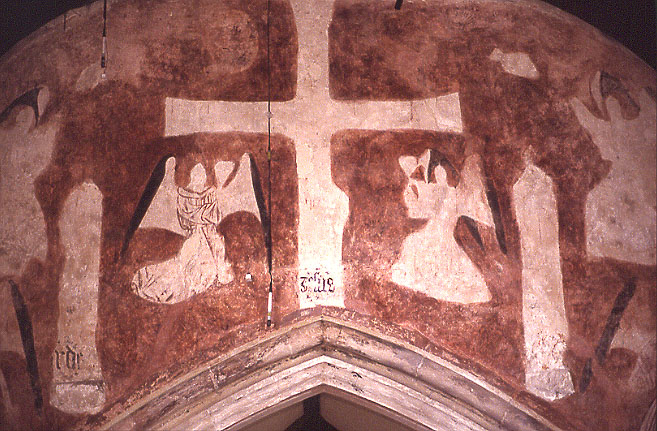Kingston, Cambridgeshire (†Ely) C.15
Rood Group, with angels and painted background

Raunds in Northamptonshire has a broadly similar example of this kind of painted background to a sculpted or carved Rood Group above the chancel arch, but the Kingston version is more elaborate – so much so as to be unique in English church wall painting. The outlines of the Rood itself and of the attendant figures of Mary and John show here against the red background, along with two painted angels swinging censers. But two other painted angels at Kingston kneel much closer to the centre on either side of the Cross below the beam. They hold up cups to catch the blood of the dying Christ, and it is this detail that is remarkable.
The blood-catching does occur elsewhere in medieval art, notably in manuscript illustration, and one intriguing and contemporary example is a miniature in the Netherlandish Hours of Yolande de Lalaing¹, where a Crucifixion with Mary and John includes a detail showing a female figure as Ecclesia, accompanied by Evangelist symbols and holding out a cup into which Christ’s blood runs. Similarities between the two end here – the two angels in the Kingston painting replace Ecclesia, the Evangelist symbols are absent, and other illustrations in the manuscript’s borders give it a specifically aristocratic-chivalric significance. Despite that though, the primary meaning of the detail is the same in both cases. The act of Atonement is displayed on the Rood, and Christ’s blood is then shed again for all in the Holy Sacrament of the Church at the moment when the priest consecrates the Host The whole painted scheme would originally have been an affirmation of the reality of Christ’s sacrifice and the Church’s mediation of its saving Grace.
Not only does such a high theme demand to be displayed where it is visible to all, the place where nave and chancel meet is the symbolically obvious one, and if there was a Doom at Kingston in the 15th century it must have painted elsewhere. None is detectable now, but there are several other paintings in the church, some of them earlier than the Rood Group, and they will be here in due course.
* This painting is hard to place within a categorical scheme. Since it is more than merely background decoration, it is linked here with other paintings of the Crucifixion, but there are links to/from the Painted backgrounds Introduction page as well.
¹ MS.Douce 93, ff.100v-101. Bodleian Library, Oxford. Reproduction in J.Harthan, Books of Hours and their owners, Thames & Hudson, 1978, pp.142-143. [On the opposite page to the Crucifixion miniature is the Creed of St Athanasius]